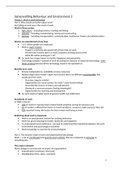Summary
Summary Behaviour & Environment: Behaviour in Organisations (SOW-PSB2BE10EA)
- Course
- Institution
Summary of both the lectures and all the literature of Behaviour and Environment: Behaviour in Organisations. I used this document to study for the exam and my grade was a 7.5.
[Show more]



